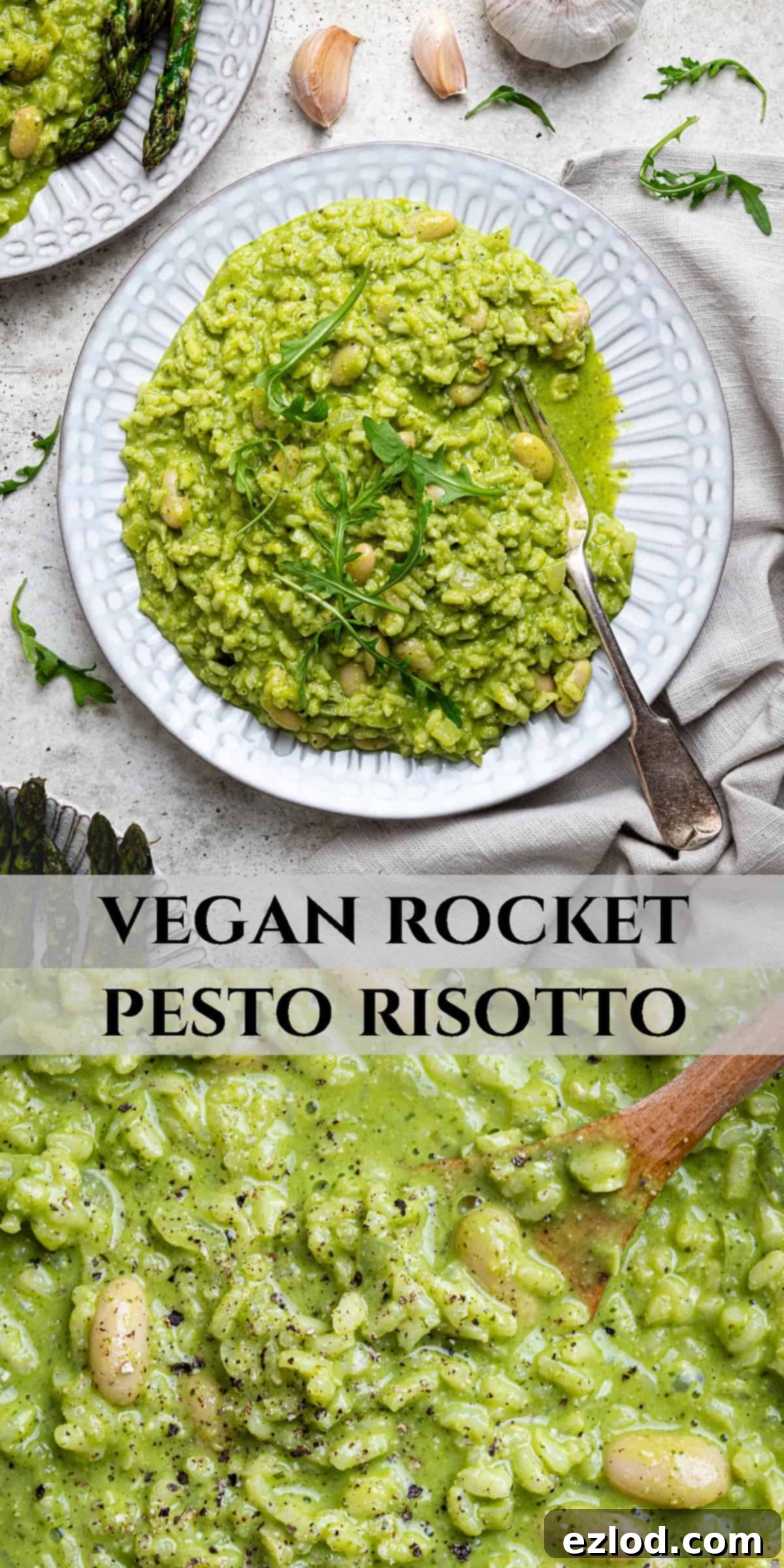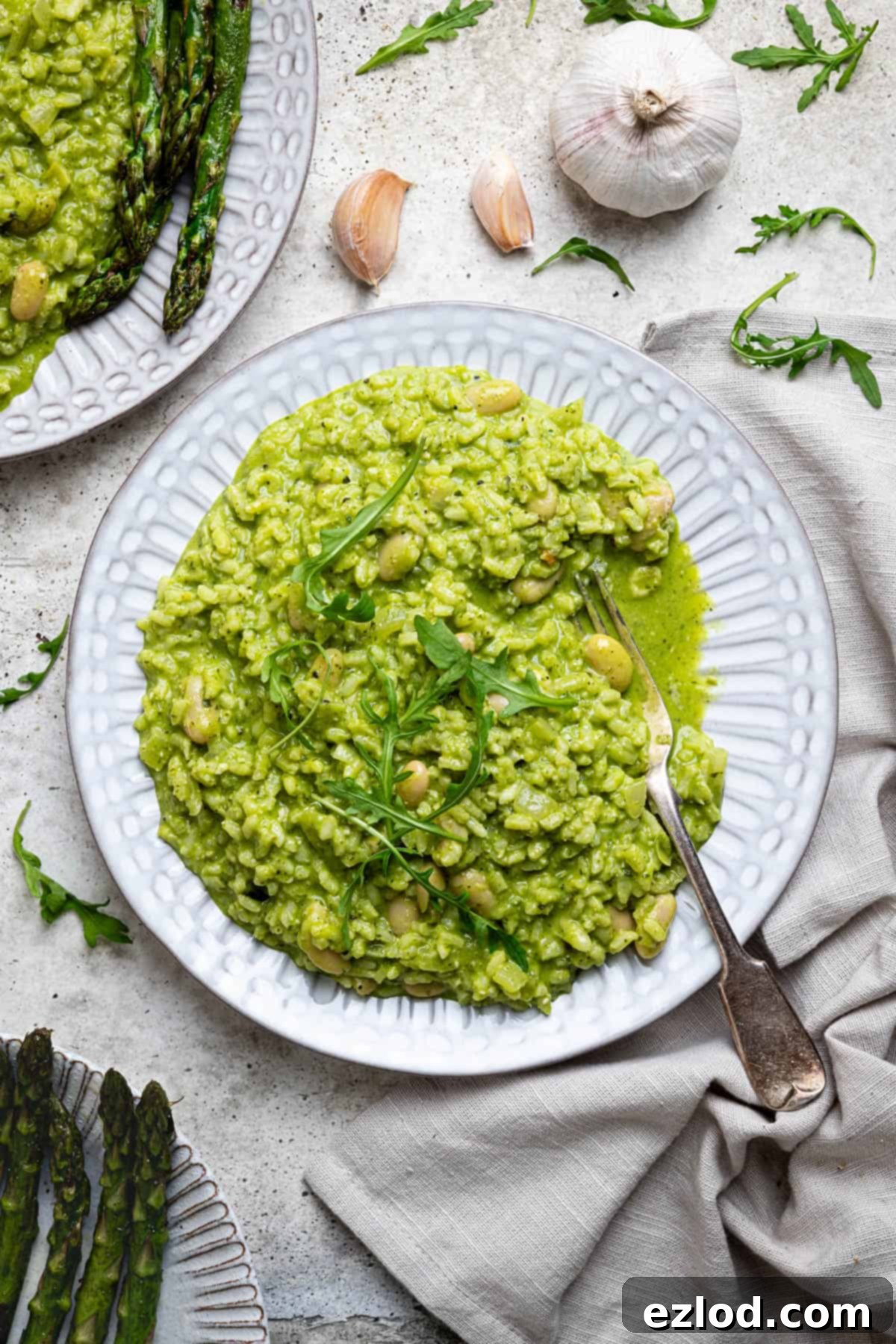Mastering Vegan Rocket Pesto Risotto: A Step-by-Step Guide to Creamy Perfection
Embark on a culinary journey with this truly exquisite vegan rocket pesto risotto. It’s a dish that artfully combines fresh, vibrant flavors with a luxurious, creamy texture, making it a showstopper for any occasion. Imagine the delicate peppery notes of rocket (arugula) mingling with bright lemon and fragrant herbs, all unified in a satisfyingly rich risotto base. This isn’t just another weeknight meal; it’s an experience designed to impress your guests, yet it remains wonderfully approachable as a comforting, soul-satisfying dinner for any day of the week.
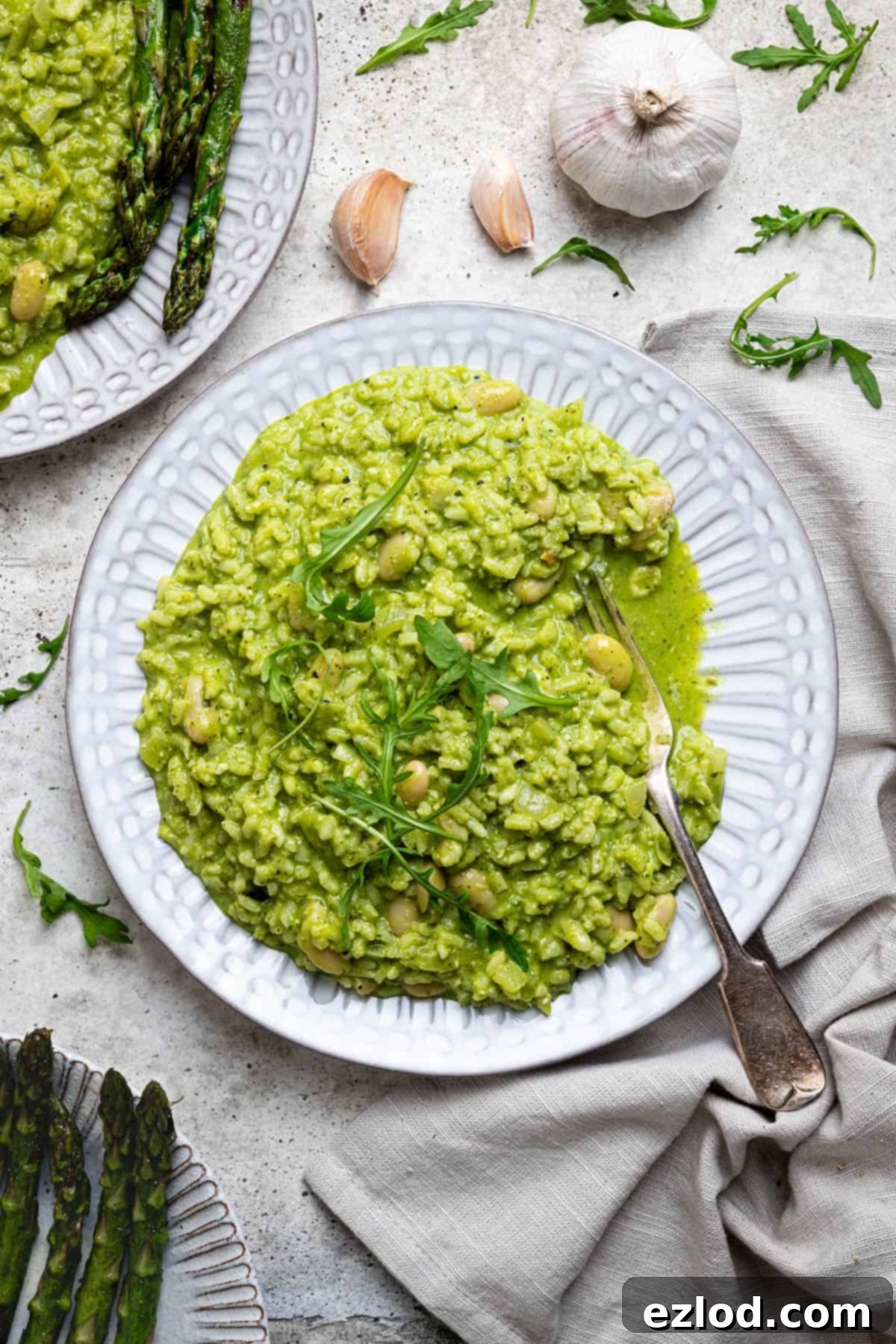
For years, I’ve cherished pesto risotto, often relying on the convenience of shop-bought pesto. While certainly good, the revelation of crafting homemade pesto transformed this dish entirely. This vegan rocket pesto risotto, now a firm favorite, truly exemplifies the difference. The homemade pesto elevates the entire experience, infusing the risotto with an unparalleled freshness and depth of flavor that store-bought versions simply can’t replicate. The synergy of fresh herbs, the zesty kick of lemon, and the distinct peppery bite of rocket (arugula) creates a vibrant and incredibly moreish taste that will have you coming back for seconds.
Creating your own pesto allows you to control the quality of ingredients, customize the flavor profile, and avoid unwanted additives often found in commercial products. This homemade approach not only enhances the taste but also aligns perfectly with a wholesome, plant-based lifestyle. The rich green color and aromatic scent of freshly blended pesto bring an extra layer of sensory pleasure to the cooking process, hinting at the deliciousness to come.
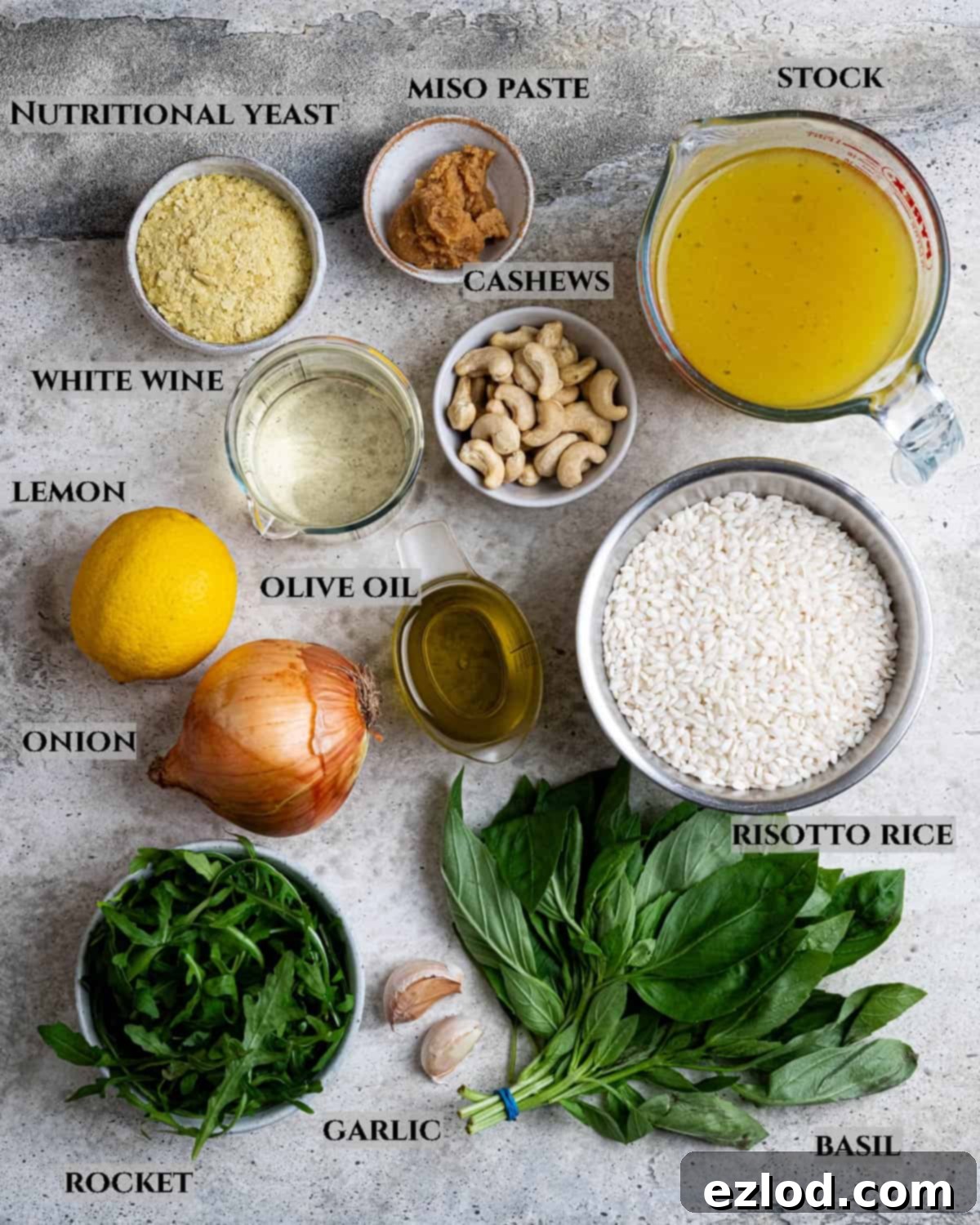
Key Ingredients for an Exceptional Vegan Rocket Pesto Risotto
The secret to any outstanding dish lies in its ingredients. For this vegan rocket pesto risotto, each component plays a crucial role in building its complex, satisfying flavor and signature creamy texture. Here’s a closer look at what you’ll need and why:
- Risotto Rice: This is non-negotiable for achieving the classic creamy risotto texture. Unlike long-grain rice, short-grain risotto varieties like Arborio or Carnaroli are high in starch. This starch is released as the rice is stirred and cooks, creating the desirable velvety consistency. It’s vital not to rinse the rice before cooking, as this would wash away the precious starches needed for that perfect creaminess.
- Rocket (Arugula) and Basil: These fresh greens form the heart of our vibrant pesto. Rocket, also known as arugula, contributes a distinct peppery, slightly bitter note that adds an exciting edge. Fresh basil provides a sweet, aromatic, and herbaceous foundation, balancing the rocket’s pungency beautifully. Using both creates a complex and deeply flavorful pesto.
- Miso Paste: A true game-changer in vegan cooking, white miso paste provides an incredible depth of umami flavor. In this recipe, it cleverly steps in to replace the savory, salty notes traditionally provided by Parmesan cheese, ensuring a rich, satisfying taste without any dairy. Its fermented quality also adds a subtle complexity that enhances the overall profile.
- Cashews: These unsung heroes contribute a wonderful richness and creaminess to the pesto, acting as a superb alternative to traditional pine nuts. When blended, cashews create a smooth, buttery texture. If cashews aren’t available or preferred, you can easily substitute them with pine nuts, sunflower seeds, or walnuts, though the flavor profile will subtly change.
- Lemon: Fresh lemon juice is indispensable. It brightens the entire dish, cutting through the richness with its zingy, acidic notes. Lemon enhances the flavors of the herbs and rocket, providing that irresistible freshness. Always opt for fresh lemon juice if possible, as it offers a superior, more vibrant taste, though bottled lemon juice can work in a pinch.
- Onion and Garlic: The aromatic foundation of any great risotto. Finely chopped onion is slowly cooked to sweetness, building a foundational layer of flavor. Garlic, added later to prevent burning, introduces its pungent, savory notes that complement both the pesto and the rice base. White or brown onions work equally well, as do shallots for a slightly milder flavor.
- Vegetable Stock: The liquid base of our risotto. The quality of your stock matters immensely, so choose a good quality vegetable stock or bouillon. I personally favor brands like Marigold for their rich, well-rounded flavor. Keeping the stock warm throughout the cooking process is crucial; adding cold stock will shock the rice and interrupt the creamy starch release.
- White Wine: A classic risotto ingredient, white wine adds significant depth and acidity, deglazing the pan and infusing the rice with a subtle, sophisticated flavor. While you can omit it if you avoid alcohol, I highly recommend including it for the best flavor profile. Remember to check the label to ensure your chosen white wine is vegan-friendly, as not all wines are.
- Nutritional Yeast: This magical ingredient is a staple in vegan kitchens for a reason. It imparts an extra savory, ‘cheesy’ hint, further enhancing the umami profile of the dish and contributing to that overall feeling of richness and indulgence.
- Olive Oil: Essential for both the pesto and sautéing the risotto aromatics. Using extra virgin olive oil for the pesto will lend a superior, fruitier flavor, while a good quality regular olive oil is perfect for the initial cooking steps.
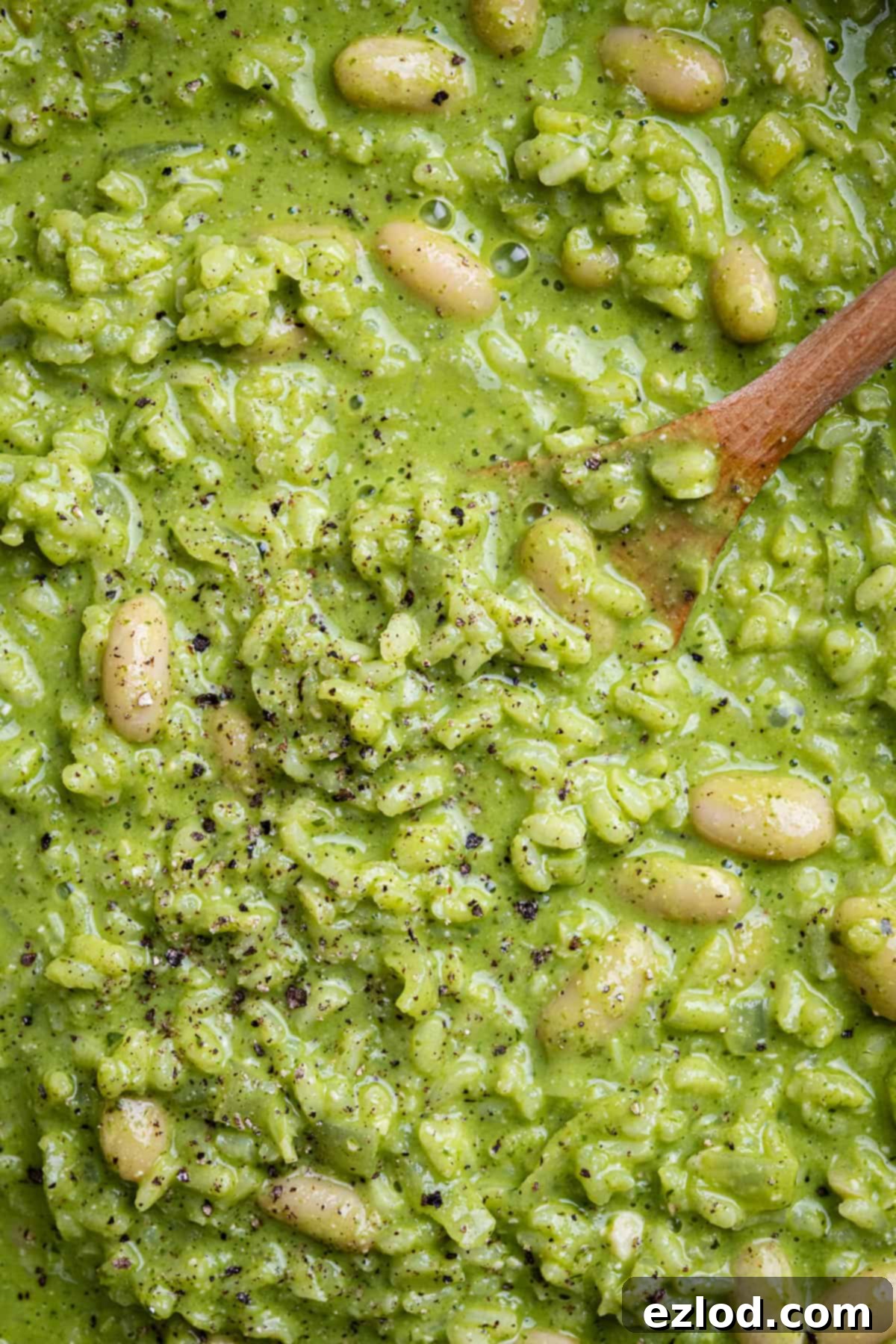
Crafting Your Vegan Rocket Pesto Risotto: A Step-by-Step Guide
(For precise measurements and detailed instructions, please refer to the comprehensive recipe card located at the very bottom of this page.)
Making a truly great risotto, especially a vegan one, is a labor of love that rewards patience with incredibly delicious results. Here’s a breakdown of the process to ensure your rocket pesto risotto is nothing short of perfect:
Step 1: Prepare Your Vibrant Rocket Pesto
The heart of this dish is the fresh, homemade pesto. Begin by combining the cashews, fresh rocket and basil, peeled garlic cloves, miso paste, fresh lemon juice, nutritional yeast, and extra virgin olive oil in a high-speed blender or food processor. Blend until the mixture is very finely chopped and achieves a relatively smooth, vibrant green consistency. You may need to stop and scrape down the sides a few times to ensure everything is evenly incorporated. The goal is a pesto that’s not quite a paste, but definitely not chunky, allowing its flavors to meld beautifully into the risotto.
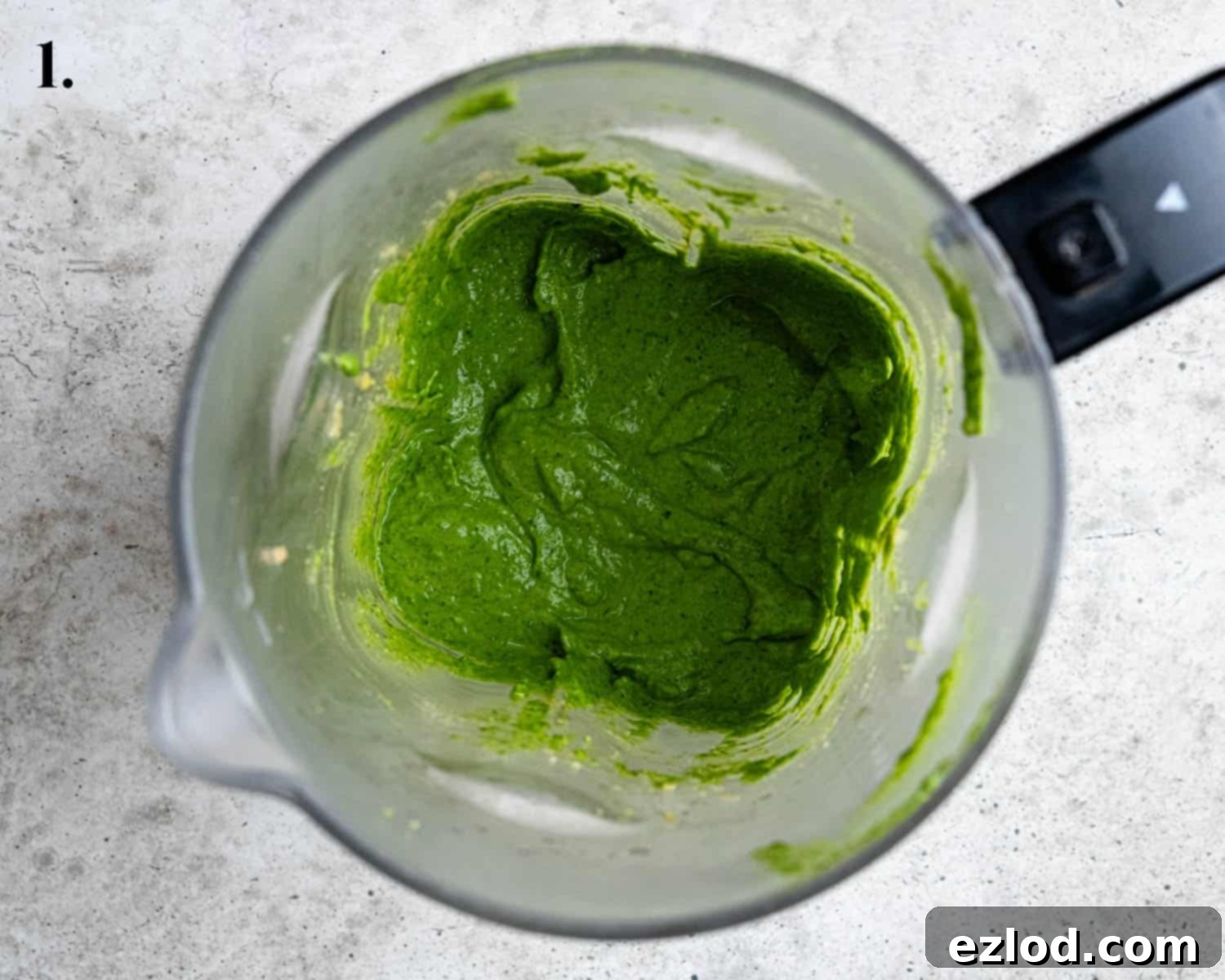
Step 2: Build the Aromatic Foundation
In a large, heavy-bottomed pan or Dutch oven, heat a generous drizzle of olive oil over medium heat. Add the finely chopped onion and cook gently for about 10 minutes, stirring occasionally, until it becomes soft, translucent, and slightly sweet. Avoid browning the onion too much. Once the onion is ready, stir in the crushed garlic and cook for just another minute until fragrant. Be careful not to burn the garlic, as this can make it bitter. Next, add the risotto rice directly to the pan and stir well, ensuring every grain is coated in the oil and aromatics. This process, known as “toasting” the rice, helps it absorb flavors and contributes to the risotto’s texture.
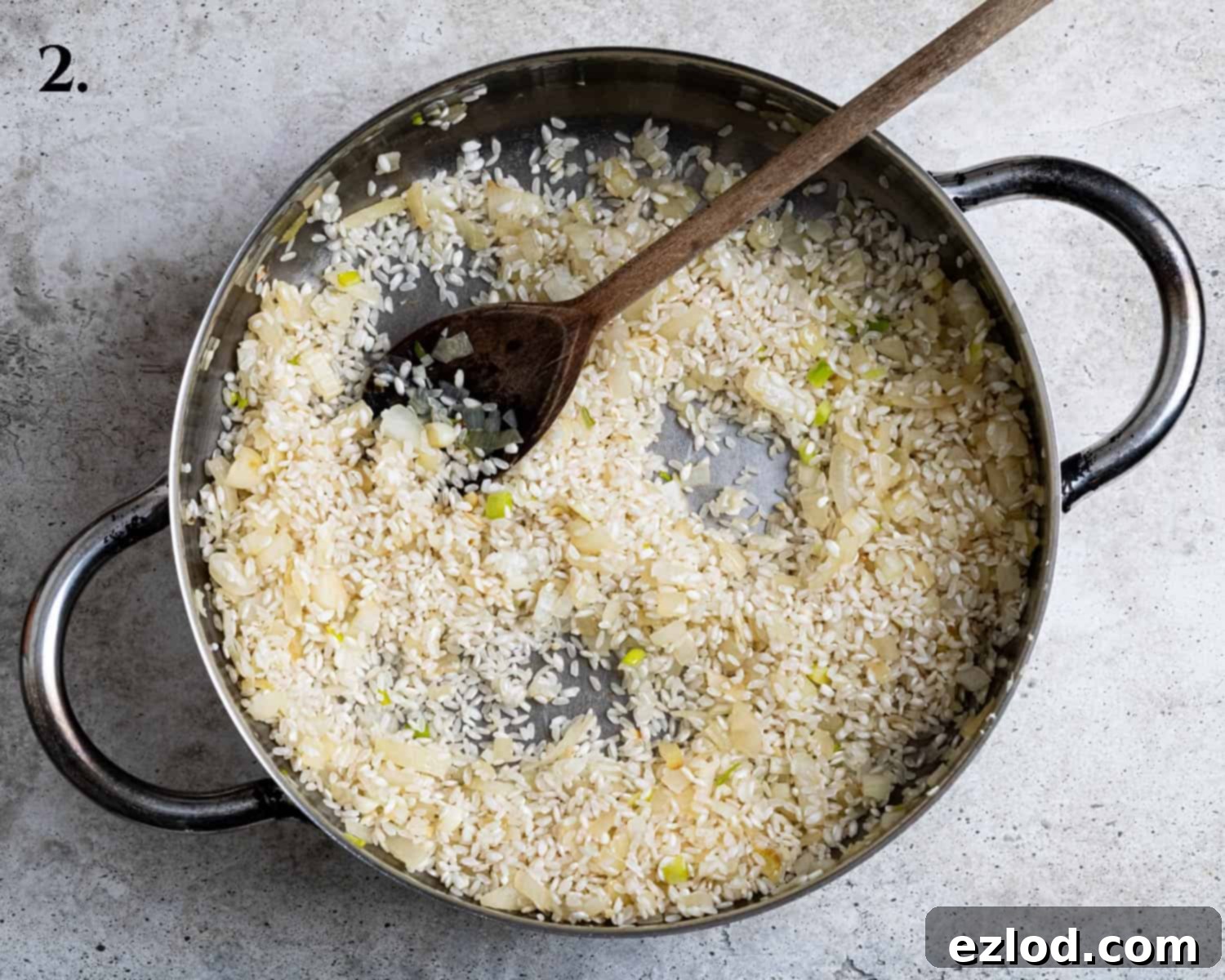
Step 3: Deglaze and Introduce the Wine
Pour in the white wine, raising the heat slightly if needed to encourage evaporation. Cook, stirring frequently, until all of the wine has been completely absorbed by the rice. You’ll notice the alcohol scent dissipating, leaving behind a wonderful depth of flavor. This step is crucial for adding complexity to the risotto. Once absorbed, it’s time to start adding your warmed vegetable stock.
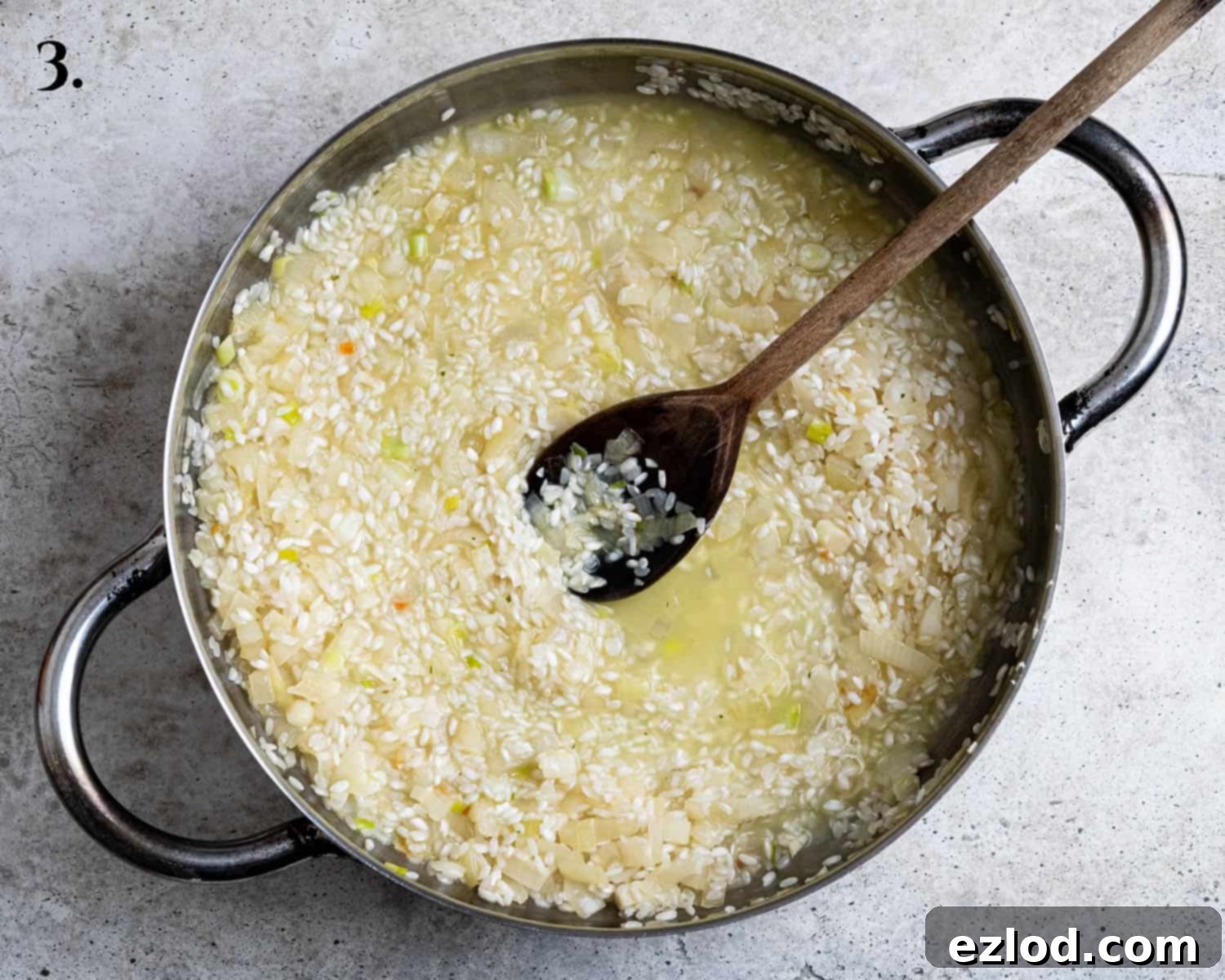
Step 4: The Art of Gradual Stock Addition
Now, the core of risotto making: add the warmed vegetable stock gradually. Begin by adding a single ladleful of stock to the rice. Stir constantly but gently, allowing the rice to slowly absorb the liquid and release its starches. Only when one ladleful is almost fully absorbed should you add the next. Continue this process, adding a ladleful or two at a time, and stirring frequently, for about 20-25 minutes, or until the rice is tender with a slight bite (al dente) and the risotto has achieved its characteristic creamy, flowing consistency. If you’re incorporating cannellini beans for extra protein, stir them in during the last few minutes of cooking to warm through.
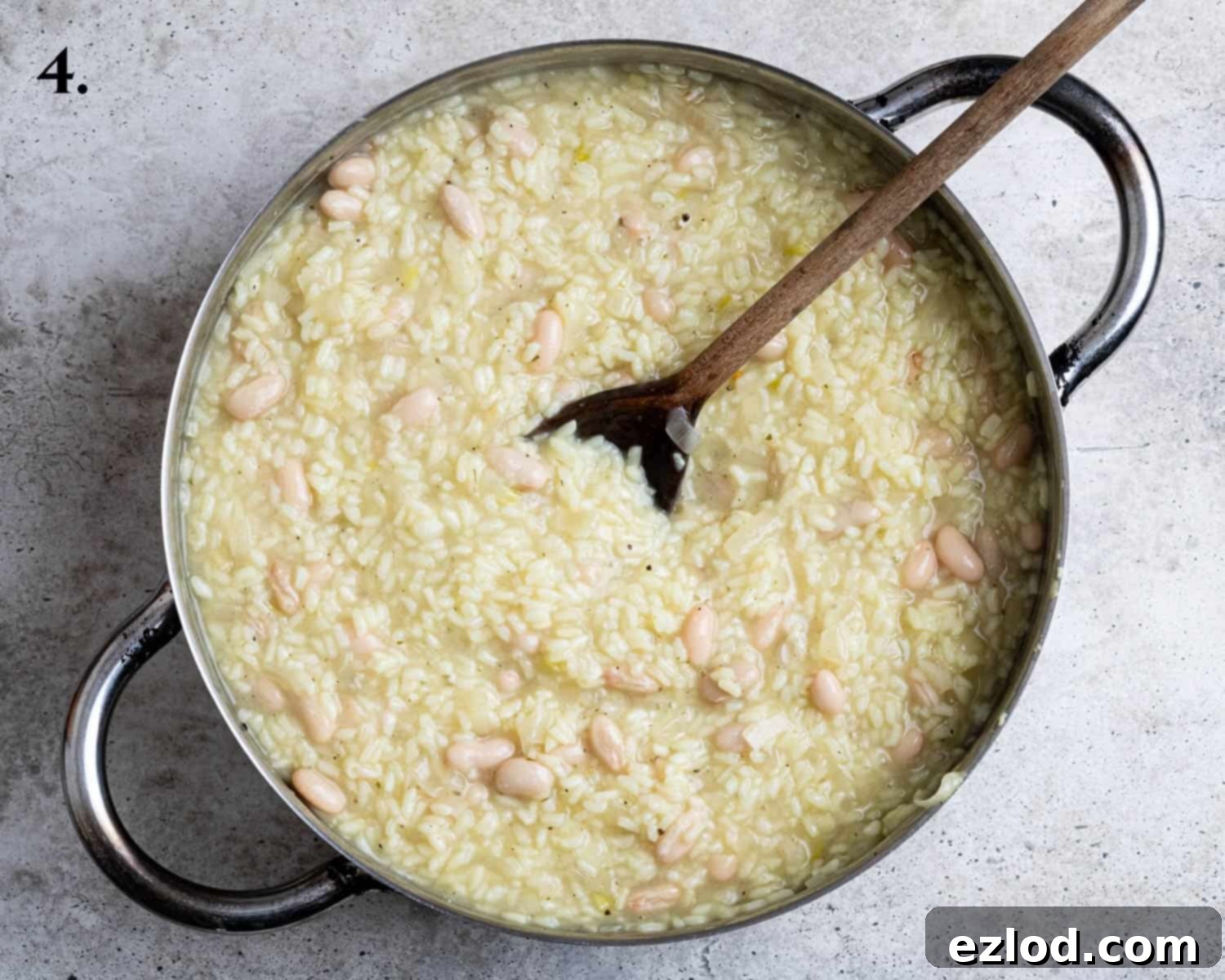
Step 5: Final Touches and Serving
Once the risotto has reached its perfect texture, remove it from the heat. Stir in the freshly made rocket pesto, ensuring it’s thoroughly combined and beautifully colors the risotto. Add a generous grinding of fresh black pepper. Now is the time to taste and adjust the seasoning as needed. Remember that miso paste in the pesto is quite salty, so you may not need much, if any, additional salt. Serve immediately, garnished perhaps with a few extra rocket leaves or a squeeze of lemon for added zing.
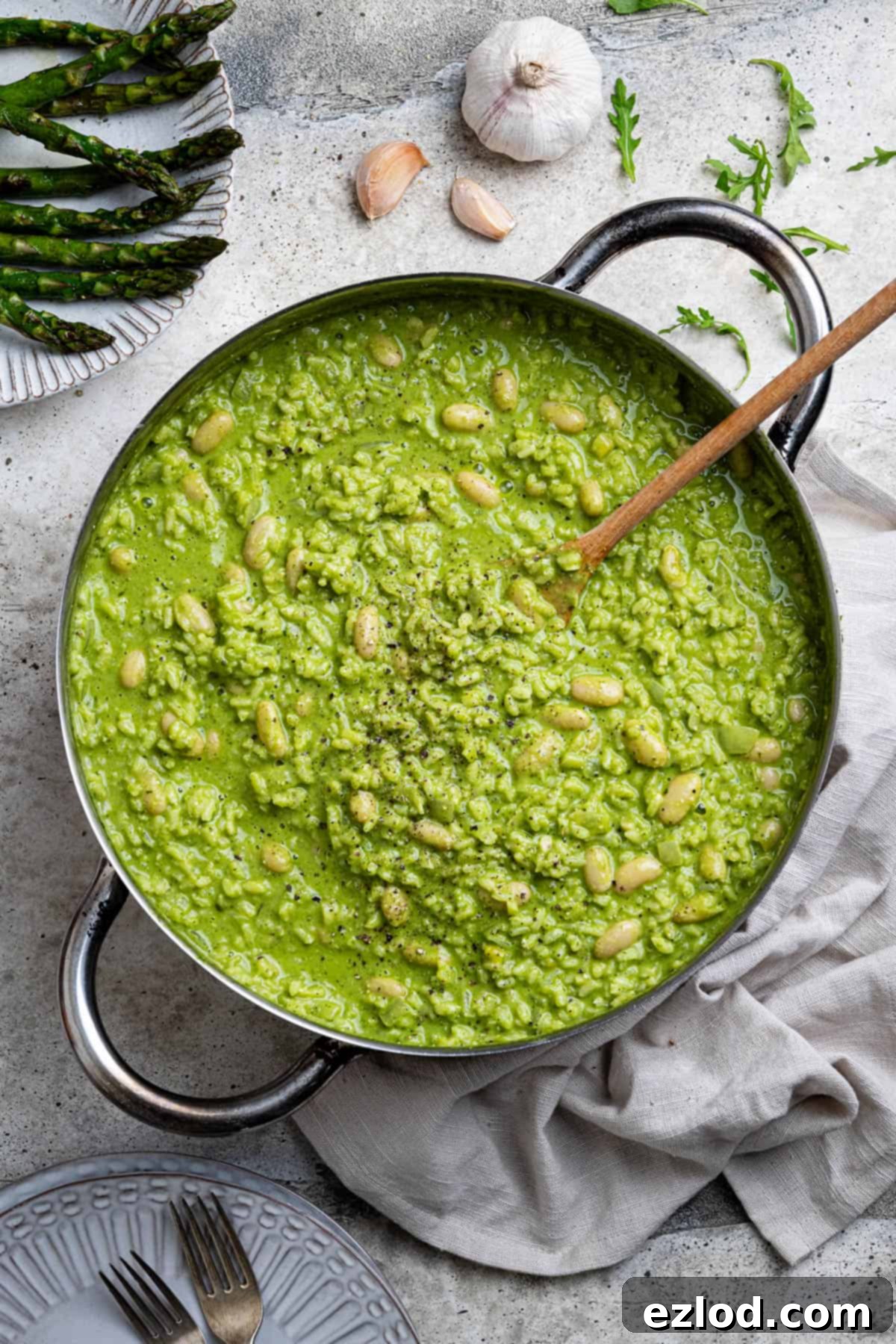
Expert Tips for the Best Vegan Rocket Pesto Risotto
Achieving risotto perfection requires a few insider tricks. Here are some top tips to ensure your vegan rocket pesto risotto is incredibly creamy, flavorful, and perfectly cooked every time:
- The Art of Constant Stirring: This is arguably the most crucial step for a great risotto. Stirring the rice almost constantly is essential. It helps release the starch from the grains, which is what creates that signature creamy texture. While it might sound tedious, many find it quite meditative. Put on some favorite music, pour yourself a glass of the white wine you’re using (if you wish!), and enjoy the process. Consistent stirring also prevents the rice from sticking to the bottom of the pan and ensures even cooking.
- Adjusting Stock for Texture: The exact amount of stock needed can vary. Factors like the brand of risotto rice, the humidity in your kitchen, and your preferred consistency all play a role. For a looser, more flowing risotto (like mine), use approximately 1.5 liters of stock. If you prefer a thicker, more compact consistency, start with 1.25 liters and adjust from there. Always have extra warm stock on hand, just in case.
- Boost Creaminess (Optional): For an extra luxurious and ultra-creamy risotto, consider stirring in a tablespoon or two of good quality vegan cream (such as oat, soy, or cashew cream) at the very end of the cooking process, just before adding the pesto. If you choose this option, you might want to slightly reduce the initial amount of vegetable stock.
- Seasoning Strategy: Hold off on adding salt until the very end, after you’ve stirred in the pesto. Miso paste, a key ingredient in our pesto, is naturally quite salty, as is much store-bought vegetable stock. By seasoning at the end, you can taste the full flavor profile and adjust precisely, preventing an overly salty dish. Often, with the miso and stock, additional salt isn’t even necessary.
- Mise en Place is Your Friend: Before you even turn on the stove, ensure all your ingredients are prepped and measured. Chop the onion and garlic, measure out your rice, have your pesto ingredients ready, and most importantly, heat your vegetable stock and keep it simmering gently on a separate burner. This organized approach makes the risotto-making process smooth and enjoyable, preventing any rushed scrambling.
- Choose the Right Pan: A wide, shallow pan or a Dutch oven is ideal for making risotto. The wider surface area allows the liquid to evaporate more evenly and gives you plenty of room to stir the rice effectively, promoting consistent cooking and starch release.
- Keep Your Stock Warm: Always add warm or hot stock to your risotto. Adding cold stock will significantly drop the temperature of the rice, shocking the grains and interrupting the cooking process, which can lead to a less creamy and unevenly cooked risotto.
Frequently Asked Questions About Vegan Rocket Pesto Risotto
While risotto is truly best enjoyed freshly cooked when its creamy texture is at its peak, any leftovers are perfectly safe to store. They will keep well in an airtight container in the fridge for 2-3 days. For longer storage, you can absolutely freeze individual portions. Allow the risotto to cool completely before transferring it to freezer-safe containers. When reheating, it’s crucial to do so very thoroughly, stirring frequently, and you may want to add a splash of vegetable stock or water to help revive its creamy consistency.
This rocket pesto risotto is incredibly versatile and pairs beautifully with a variety of sides. For an added protein boost, I often stir in a can of drained cannellini beans during the last few minutes of cooking – butter beans would also work wonderfully. Other great protein additions include pan-seared grilled tofu or vegan chicken alternatives. As for vegetables, grilled asparagus makes a fantastic complement, as does a simple, crisp green salad dressed with a light vinaigrette. If you’re looking to truly indulge, serve it alongside freshly baked focaccia for dipping into the creamy goodness. Sautéed wild mushrooms, roasted cherry tomatoes, or even a sprinkle of toasted pumpkin seeds for crunch would also be delightful.
Absolutely! While I firmly believe that homemade pesto elevates this dish to an entirely new level of fresh and vibrant flavor, using a good quality jar of shop-bought vegan pesto is a perfectly acceptable and convenient alternative. It’s a great option for a quicker meal or when you’re looking for a store-cupboard friendly solution. Just be aware that the depth and complexity of flavor might not be quite the same as a freshly blended pesto.
Technically, you *could* use long-grain or basmati rice, but I strongly advise against it. These rice varieties lack the high starch content and absorption properties of traditional risotto rice. To achieve the signature creamy, velvety consistency that defines a classic risotto, you truly need a short-grain risotto rice like Arborio or Carnaroli. These grains release their starches as they cook and are stirred, creating the desired creamy emulsion. In a pinch, paella rice or even pudding rice might offer a closer texture than long-grain, but Arborio or Carnaroli remains the best choice for authentic results.
Yes, this recipe is naturally gluten-free! All the ingredients listed – risotto rice, rocket, basil, cashews, miso paste, lemon, onion, garlic, vegetable stock, white wine, nutritional yeast, and olive oil – are inherently gluten-free. Just be sure to double-check the labels of your vegetable stock and white wine to ensure they don’t contain any hidden gluten-containing ingredients, as formulations can vary by brand.
If your risotto seems too thick, simply stir in a splash more warm vegetable stock (or even a little hot water) until it reaches your desired creamy, flowing consistency. If it’s too thin, continue to cook and stir gently for a few more minutes to allow more liquid to evaporate and the starch to further thicken the sauce. Patience is key here; don’t rush it!
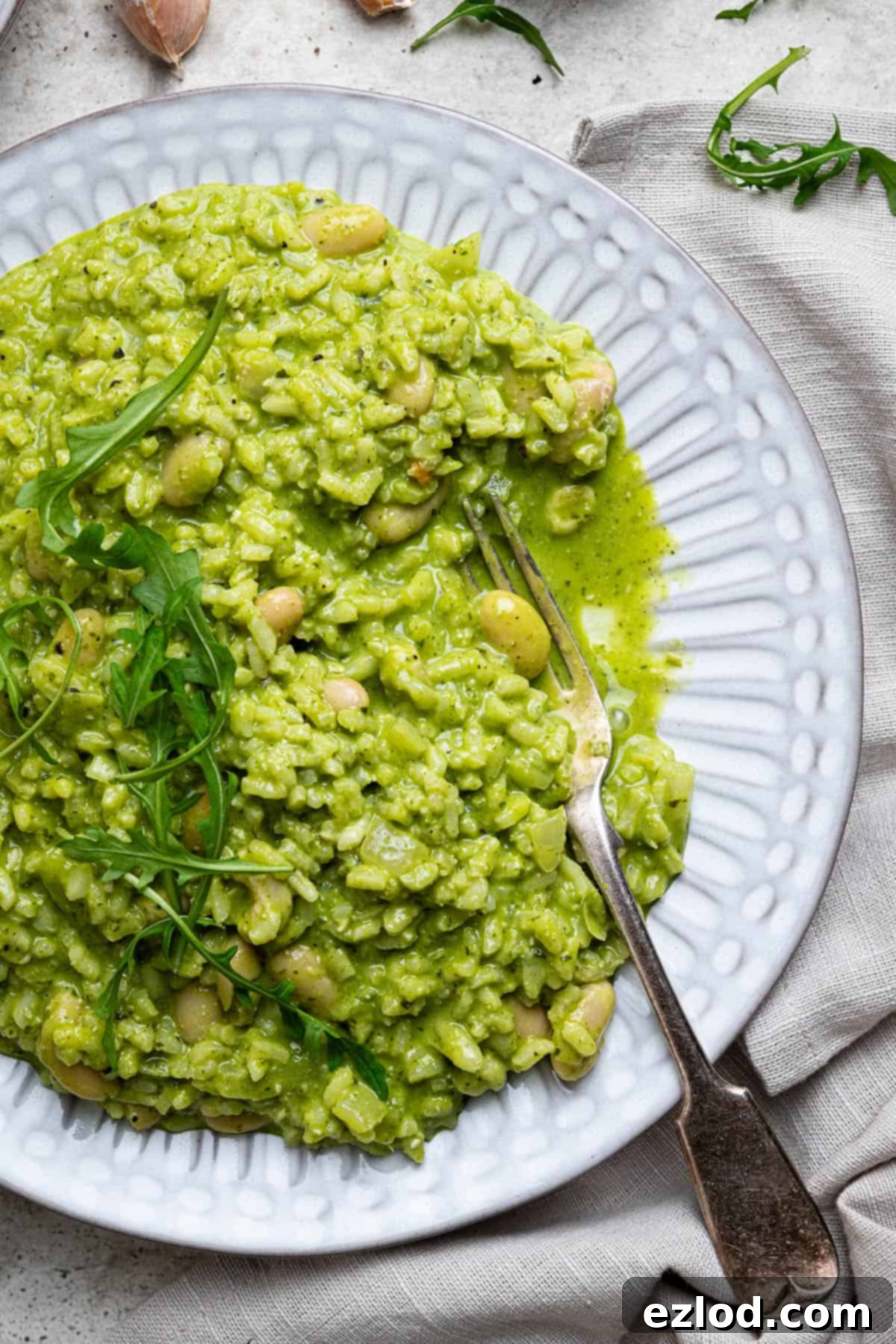
If you tried this fresh and flavorful vegan rocket pesto risotto recipe, please let me know how it turned out! I’d love for you to rate it, leave a comment below, or tag @domestic_gothess on Instagram using the hashtag #domesticgothess. Your feedback is truly appreciated!
All images and content featured on Domestic Gothess are protected by copyright. If you wish to share this delightful recipe, please do so by utilizing the provided share buttons. We kindly request that you do not screenshot or post the recipe or its content in full; instead, include a direct link back to this original post for the complete recipe. Thank you for respecting our work!

Print
Rocket Pesto Risotto (Vegan)
Ingredients
For the Rocket Pesto:
- 50 g (heaped ⅓ cup) raw cashews
- 60 g (2 oz) fresh basil leaves
- 60 g (2 oz) fresh rocket (arugula)
- 2 cloves garlic peeled and roughly chopped
- 4 Tablespoons nutritional yeast
- 2 Tablespoons white miso paste
- juice of 1 large lemon
- 100 ml (⅓ cup + 4 teaspoons) extra virgin olive oil
For the Risotto:
- 1 Tablespoon olive oil
- 1 large onion finely chopped
- 2 cloves garlic peeled and crushed
- 350 g (1 + ¾ cups) risotto rice (Arborio or Carnaroli)
- 120 ml (½ cup) dry white wine
- 1.25 – 1.5 litres (5-6 cups) warm vegetable stock
- 400 g (14 oz) tin cannellini beans drained and rinsed (optional, for added protein)
- freshly ground black pepper to taste
Instructions
-
To prepare the homemade rocket pesto: In a blender or food processor, combine the cashews, fresh rocket, fresh basil, peeled garlic, white miso paste, fresh lemon juice, nutritional yeast, and extra virgin olive oil. Blend until the mixture is very finely chopped and has a smooth, vibrant green consistency. Set aside.
-
To begin the risotto: Heat a tablespoon of olive oil in a large, heavy-bottomed pan or Dutch oven over medium heat. Add the finely chopped onion and cook gently for about 10 minutes, stirring occasionally, until it is soft, translucent, and slightly sweet. Next, add the crushed garlic and cook for another minute until fragrant, being careful not to burn it.
-
Add the risotto rice to the pan and stir well for 1-2 minutes, ensuring every grain is coated in the oil and aromatics. Pour in the white wine and cook, stirring frequently, until all the liquid has been completely absorbed by the rice.
-
Begin adding the warm vegetable stock, one to two ladlefuls at a time. Stir the risotto constantly and gently, allowing each addition of stock to be mostly absorbed before adding the next. Continue this gradual process for approximately 20-25 minutes, or until the rice is tender with a slight al dente bite and the risotto has reached a creamy, flowing consistency. If you are using the optional cannellini beans, stir them in during the last 3-5 minutes of cooking to heat through.
-
Once the risotto is cooked to your liking, remove the pan from the heat. Stir in the prepared rocket pesto until thoroughly combined and the risotto takes on a beautiful green hue. Add a good grinding of fresh black pepper. Taste and adjust seasoning as needed, bearing in mind the miso paste contributes saltiness. Serve immediately.
Notes
- For detailed tips, ingredient insights, and step-by-step photos, please refer to the main article above the recipe card.
- The amount of vegetable stock required can vary slightly based on the type of risotto rice used and your preferred final consistency. Use 1.5 liters for a looser, creamier risotto, or 1.25 liters for a slightly thicker texture. Always keep extra warm stock on hand.
